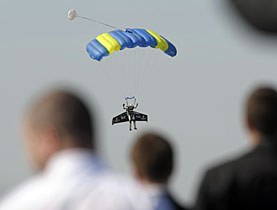“Fusionman” flies across the English Channel

Is it a bird? Is it a plane? No, it's Fusionman – daredevil Swiss pilot Yves Rossy – who on Friday crossed the English Channel propelled by a homemade jet-powered wing.
The 49-year-old commercial airline pilot shot across the 35 kilometres from Calais in northern France to Dover in England at an average speed of 200 kilometres per hour.
After two previous attempts were postponed because of bad weather, everything went to plan for Rossy’s 13-minute flight, helped on his way by a 25-knot tailwind.
“It went perfectly,” the Swiss Icarus told swissinfo after touching down from his historic flight. “The weather and wind were ideal. I was a very lucky man today.”
After exchanging high fives with team members, Rossy dropped from a small plane James-Bond style at an altitude of 2,500 metres over Cap Blanc Nez, near Calais. While in freefall he opened the Kevlar wing to its full extent, and with a twist of a throttle powered up the four mini jets on his wing and then flew towards the English coast.
At first he was little more than a speck against a cloudless sky, surrounded by a pair of yellow helicopters and the Pilatus plane from which he began his record-setting attempt.
As he crossed the White Cliffs of Dover just after 1.16pm, the shape of his wings soon became visible and he even had enough fuel left for some celebratory aerobatics to entertain the crowds gathered below.
Rossy then pulled the ripcord on his blue-and-yellow parachute and drifted gently downwards, waving his legs excitedly. He landed safely in the middle of a farmer’s field next to South Foreland lighthouse at St Margaret’s Bay, only to be engulfed by a mob of ecstatic colleagues, journalists, cameramen and curious cliff walkers.
“It’s difficult to describe the feeling when flying. It’s like I am in a second world,” he said. “It is a mix of reality and dreams. I am flying with a wing and just a turn of my head.”
“I was euphoric under my wing, that’s why I did some moves not in my flight plan.”
Retracing history
Rossy retraced the route of French aviator Louis Blériot, who 99 years ago became the first person to fly across the Channel in an aircraft.
“To be here in a mythic place for aviators and to be a small part of this history is a great feeling,” said the Swiss rocket man.
Like Blériot, Rossy had no navigational instruments to help him negotiate the Channel crossing, but he said that he was able to see the white cliffs from the moment he jumped.
One of the most dramatic moments on his rocket trip was the realisation after a minute of flight that he had forgotten to set his stopwatch that would allow him to calculate how much fuel he had left. “I knew I had 13 and a half minutes endurance. So I did realise after the first minute: ‘Oh, s***, I forgot [to press the stopwatch button].’
“I thought: ‘OK, just go straight and you will be fine.'”
He said that he never felt afraid during the flight. “I was under tension, but fear? The day I have fear, I don’t go.”
Human to jet-man
Rossy’s transformation from human to jet-man involved putting on a Formula-1 fireproof suit, three parachutes, two for Rossy and one for his wing, a helmet that beeps a warning when he goes too low and his homemade three-metre-wide carbon wing, which is strapped to his back and powered by four mini jets. His invention weighs about 55kg with fuel.
The wing, which he conceived, built and fine tuned himself over eight years, has no steering capability so Rossy had to control his movement using his head, shoulders and arms. The only instrument is the fuel throttle.
“It’s really a fusion between the wing and me. I am really part of this thing,” he wrote on his website.
“With hanggliding and paragliding you steer. With this you fly. It’s very natural.”
The former Swiss fighter pilot, who comes from canton Vaud, flew into the record books in 2004 when he became the first man to fly with a jet-powered wing. He has since made around 200 flights – 50 motorised – with his prototype.
But it hasn’t always been an easy ride. Rossy admits to around 20 “near-death” experiences while testing the prototype wing. During one jump in 2005, he lost control of his wing and didn’t open his parachute until he was just 500m above the ground.
To infinity and beyond
So what next for the Swiss rocket man?
Rossy says he is planning a trip to the United States to fly over the Grand Canyon.
And Fusionman believes that once he cracks the mechanics of an easy vertical take-off we could all be flying like this.
He has already sketched out the designs of a new, smaller flying machine with two engines but with double the power to be able to perform aerobatics.
He is also developing a new parachute that he could open safely at 200m rather than the current height of 800m.
Rossy says that ultimately he would like to share it with is friends, “to go out flying with five guys like the Red Arrows [formation flying team]”.
“I want to explore all the potential the wing has because the potential is enormous. I have gone down this road and I do not want to stop,” he said.
But he denies wearing a T-shirt with a capital F-letter on his chest.
“I’m just a normal man who realises his ideas. I’m not a superhero.”
swissinfo, Simon Bradley in Dover
Rossy was born on August 27, 1959 in Neuchâtel, Switzerland.
He has worked for the past ten years as a commercial pilot for the airline company, Swiss. Prior to that, he worked for 15 years as a fighter pilot for the Swiss Air Force.
An accomplished sportsman, his past and present hobbies include surfing, water-skiing, wakeboarding, parachuting, aerobatics, motorbike riding, rafting and hang-gliding.
The Swiss has long been involved in flying adventures. He is a keen sky surfer – performing aerial stunts on a board after freefalling from a plane – and was the first to sky surf from a hot air balloon.
Another Guinness record comes from being the first person to be transported between two small planes while holding onto handles on the wingtips of each plane.
Rossy zoomed into the record books on June 24, 2004 by becoming the first person to fly horizontally for four minutes with a jet-propelled wing strapped to his back.
Louis Blériot became the first man to fly across the English Channel on July 25, 1909, and the first to make an overseas flight. He touched down in Dover at 5.12am after a 37-minute flight from Calais at an average speed of 70 kilometres per hour.
Blériot was an avid inventor and aeroplane builder. He also invented a car headlamp. The Channel crossing in his 25-horsepower monoplane earned him a £1,000 (SFr2,000) reward offered by an English newspaper.
Blériot almost didn’t make it, as he had never flown for longer than 20 minutes. Several miles out from Calais his plane engine began to overheat but a sudden downpour cooled it down and he staggered to the English coast.

In compliance with the JTI standards
More: SWI swissinfo.ch certified by the Journalism Trust Initiative










You can find an overview of ongoing debates with our journalists here . Please join us!
If you want to start a conversation about a topic raised in this article or want to report factual errors, email us at english@swissinfo.ch.